Microstructure and Properties of CoCrNi/Nano-TiC/Micro-TiB2 Composite Coatings Prepared via Laser Cladding
Abstract
:1. Introduction
2. Experimental
2.1. Coating Preparation
2.2. Testing Method
3. Results and Discussion
3.1. Macroscopic Morphology and Dilution Rate
3.2. Phase Composition
3.3. Microstructure
3.4. Microhardness
3.5. Wear Resistance
4. Conclusions
- The coatings produced via laser cladding possessed good morphology characteristics without obvious pores and cracks, and the cladding layer showed strong metallurgical bonding with the matrix.
- The microstructure of the CoCrNi coating was primarily a combination of dendrites and equiaxed crystals, and the rapid solidification upon the laser cladding resulted in a uniform distribution of constituent elements. After the addition of ceramic particles, the grains were refined. The higher the amount of ceramic particles, the smaller the grains. The addition of ceramics transformed the CoCrNi-xTiC-xTiB2 composite coating from a single FCC phase to an FCC+TiC+TiB2 multiphase, and the diffraction peaks corresponding to TiC and TiB2 were subsequently enhanced when the ceramic content was increased from 10 wt.% to 30 wt.%.
- The average microhardness value of CoCrNi coatings increased by 16.37% compared with that of the substrate due to the fine grain strengthening. At 10 wt.% and 30 wt.% ceramic additions, the average microhardness values of the coatings were 328.02 HV and 494.77 HV respectively, an increase of approximately 82.02% and 174.55% compared to the substrate. This was due to the joint effect of fine grain strengthening and diffusion strengthening.
- The wear resistance of the coatings was positively correlated with the microhardness. Once the microhardness value increased, the wear amount decreased continuously. The substrate and the three sets of coatings experienced weight losses of 0.0088 g, 0.0082 g, 0.0038 g, and 0.0012 g, respectively. The addition of coating caused the change in wear mechanism of the material: while the substrate underwent adhesive, abrasive and fatigue wear, the pure CoCrNi coating suffered from adhesive and abrasive wear. Finally, the coatings with 10 wt.% and 30 wt.% ceramic contents experienced the adhesive and pitting fatigue wear mechanisms, respectively.
Author Contributions
Funding
Institutional Review Board Statement
Informed Consent Statement
Data Availability Statement
Acknowledgments
Conflicts of Interest
References
- Guimarães, B.; Guedes, A.; Fernandes, C.M.; Figueiredo, D.; Bartolomeu, F.; Miranda, G.; Silva, F.S. WC-Co/316L Stainless Steel Joining by Laser Powder Bed Fusion for Multi-Material Cutting Tools Manufacturing. Int. J. Refract. Met. Hard Mater. 2023, 112, 106140. [Google Scholar] [CrossRef]
- Hareharen, K.; Kumar, P.; Panneerselvam, T.; Babu, D.; Sriraman, N. Investigating the Effect of Laser Shock Peening on the Wear Behaviour of Selective Laser Melted 316L Stainless Steel. Opt. Laser Technol. 2023, 162, 109317. [Google Scholar] [CrossRef]
- Ding, H.; Zou, B.; Wang, X.; Liu, J.; Li, L. Microstructure, Mechanical Properties and Machinability of 316L Stainless Steel Fabricated by Direct Energy Deposition. Int. J. Mech. Sci. 2023, 243, 108046. [Google Scholar] [CrossRef]
- Su, Y.Y.; Wang, Z.F.; Xie, J.C.; Xu, G.; Xing, F.; Luo, K.Y.; Lu, J.Z. Microstructures and Mechanical Properties of Laser Melting Deposited Ti6Al4V/316L Functional Gradient Materials. Mater. Sci. Eng. A 2021, 817, 141355. [Google Scholar] [CrossRef]
- Li, P.; Yang, Q.; Li, L.; Gong, Y.; Zhou, J.; Lu, J. Microstructure Evolution and Mechanical Properties of in Situ Synthesized Ceramic Reinforced 316L/IN718 Matrix Composites. J. Manuf. Process. 2023, 93, 214–224. [Google Scholar] [CrossRef]
- Gao, Y.; Liu, Y.; Wang, L.; Yang, X.; Zeng, T.; Sun, L.; Wang, R. Microstructure Evolution and Wear Resistance of Laser Cladded 316L Stainless Steel Reinforced with in-Situ VC-Cr7C3. Surf. Coatings Technol. 2022, 435, 128264. [Google Scholar] [CrossRef]
- Zhou, X.; He, L.; Zhang, M.; Wang, P. Effect of Ceramic Particles on Microstructure and Properties of CoCrMoNbTi High-Entropy Alloy Coating Fabricated by Laser Cladding. Optik 2023, 285, 170987. [Google Scholar] [CrossRef]
- Li, Y.; Fu, H.; Wang, K.; Yang, X.; Zong, B.; Lin, J. Effect of Mo Addition on Microstructure and Wear Resistance of Laser Clad AlCoCrFeNi-TiC Composite Coatings. Appl. Surf. Sci. 2023, 623, 157071. [Google Scholar] [CrossRef]
- Li, Q.; Zhang, Y.L.; Zhang, L.; Wang, Q.; Zhao, Z.; Chen, D.X.; Jin, H.; Wang, Y.Y.; Zhang, J.W. Effect of Boron on the Microstructural Evolution and Wear Resistance of High-Hardness Fe-Based Alloy Coatings Prepared by Laser Cladding. Surf. Coatings Technol. 2023, 458, 129342. [Google Scholar] [CrossRef]
- Wang, T.; Wang, C.; Li, J.; Chai, L.; Deng, C.; Luo, J.; Huang, Y. Microstructure and Properties of Laser-Clad High Entropy Alloy Coating on Inconel 718 Alloy. Mater. Charact. 2022, 193, 112314. [Google Scholar] [CrossRef]
- Yu, J.; Qiao, C.; Zhang, S.; Liu, Z.; Wróblewski, P. Tribological Properties of Laser-Cladded Fe-Based Amorphous Composite Coatings under Dry and Lubricated Sliding. Opt. Laser Technol. 2023, 166, 109583. [Google Scholar] [CrossRef]
- Ning, J.; Lan, Q.; Zhu, L.; Xu, L.; Yang, Z.; Xu, P.; Xue, P.; Xin, B. Microstructure and Mechanical Properties of SiC-Reinforced Inconel 718 Composites Fabricated by Laser Cladding. Surf. Coatings Technol. 2023, 463, 129514. [Google Scholar] [CrossRef]
- Ding, H.; Cao, Y.; Hua, K.; Tong, Y.; Li, N.; Sun, L.; Li, X.; Wu, H.; Wang, H. Fretting Wear Resistance at Ambient and Elevated Temperatures of 316 Stainless Steel Improved by Laser Cladding with Co-Based alloy/WC/CaF2 Composite Coating. Opt. Laser Technol. 2023, 163, 109428. [Google Scholar] [CrossRef]
- Zhu, L.; Xue, P.; Lan, Q.; Meng, G.; Ren, Y.; Yang, Z.; Xu, P.; Liu, Z. Recent Research and Development Status of Laser Cladding: A Review. Opt. Laser Technol. 2021, 138, 106915. [Google Scholar] [CrossRef]
- Chang, W.C.; Lu, Y.C.; Hsueh, C.H. Oxide Dispersion Strengthening of CoCrNi Medium Entropy Alloy Using TiO2 Particles. Mater. Sci. Eng. A 2022, 859, 144196. [Google Scholar] [CrossRef]
- Bi, X.; Li, R.; Li, T.; Zhang, X.; Cheng, J.; Tian, Y. Cracks Suppression Strategies for CoCrNi Medium Entropy Alloy Fabricated by Laser Directed Energy Deposition. Mater. Des. 2023, 226, 111579. [Google Scholar] [CrossRef]
- Gupta, A.; Jian, W.R.; Xu, S.; Beyerlein, I.J.; Tucker, G.J. On the Deformation Behavior of CoCrNi Medium Entropy Alloys: Unraveling Mechanistic Competition. Int. J. Plast. 2022, 159, 103442. [Google Scholar] [CrossRef]
- Lin, Y.S.; Lu, Y.C.; Hsueh, C.H. Strengthening of CoCrNi Medium Entropy Alloy with Gadolinium Additions. Vacuum 2023, 211, 111969. [Google Scholar] [CrossRef]
- Liu, C.; Qiu, X.; Peng, J.; Wang, Z. Structure and Properties of Laser Cladding CoCrNi Multicomponent Alloy Coating Used in Rain Gauge. Opt. Lasers Eng. 2023, 163, 107458. [Google Scholar] [CrossRef]
- Ma, G.; Cui, H.; Jiang, D.; Chen, H.; Hu, X.; Zhang, G.; Wang, R.; Sun, X.; Song, X. The Evolution of Multi and Hierarchical Carbides and Their Collaborative Wear-Resisting Effects in CoCrNi/WC Composite Coatings via Laser Cladding. Mater. Today Commun. 2022, 30, 103223. [Google Scholar] [CrossRef]
- Chen, L.; Yu, T.; Guan, C.; Zhao, Y. Microstructure and Properties of Metal Parts Remanufactured by Laser Cladding TiC and TiB2 Reinforced Fe-Based Coatings. Ceram. Int. 2022, 48, 14127–14140. [Google Scholar] [CrossRef]
- Wang, C.; Li, R.; Bi, X.; Yuan, W.; Gu, J.; Chen, J.; Yan, M.; Zhang, Z. Microstructure and Wear Resistance Property of Laser Cladded CrCoNi Coatings Assisted by Ultrasonic Impact Treatment. J. Mater. Res. Technol. 2023, 22, 853–864. [Google Scholar] [CrossRef]
- Zhuang, D.D.; Tao, W.W.; Du, B.; Zhang, S.H.; Lian, X.L.; Wang, F. Microstructure and Properties of TiC-Enhanced CrMnFeCoNi High-Entropy Alloy Coatings Prepared by Laser Cladding. Tribol. Int. 2023, 180, 108246. [Google Scholar] [CrossRef]
- Wang, J.; Zou, J.; Yang, H.; Huang, H.; Liu, Z.; Ji, S. Strength Improvement of CoCrNi Medium-Entropy Alloy through Introducing Lattice Defects in Refined Grains. Mater. Charact. 2022, 193, 112254. [Google Scholar] [CrossRef]
- Deshmukh, P.S.; Sathiaraj, G.D. Microstructure, Mechanical Properties, and Strain Rate Sensitivity of Vacuum Arc Melted CoCrNi Medium Entropy Alloy. Mater. Today Proc. 2023, 2–5. [Google Scholar] [CrossRef]
- Buzolin, R.H.; Richter, T.; Pixner, F.; Rhode, M.; Schroepfer, D.; Enzinger, N. Microstructure and Texture Characterisation of Friction Stir Welded CoCrNi and CoCrFeMnNi Multi-Principle Element Alloys. Mater. Today Commun. 2023, 35, 105870. [Google Scholar] [CrossRef]
- Wang, H.; Zhang, W.; Peng, Y.; Zhang, M.; Liu, S. Microstructures and Wear Resistance of FeCoCrNi-Mo High Entropy Alloy/Diamond Composite Coatings by High Speed Laser Cladding. Coatings 2020, 10, 300. [Google Scholar] [CrossRef]
- Zhai, W.; Nan, J.; Sun, L.; Wang, Y.; Wang, S. Preparation, Microstructure, and Interface Quality If Cr3C2-NiCr Cladding Layer on the Surface of Q235 Steel. Coatings 2023, 13, 676. [Google Scholar] [CrossRef]
- Wang, D.; Dou, W.; Ou, Y.; Yang, Y.; Tan, C.; Zhang, Y. Characteristics of Droplet Spatter Behavior and Process-Correlated Mapping Model in Laser Powder Bed Fusion. J. Mater. Res. Technol. 2021, 12, 1051–1064. [Google Scholar] [CrossRef]
- Gunenthiram, V.; Peyre, P.; Schneider, M.; Dal, M.; Coste, F.; Koutiri, I.; Fabbro, R. Experimental Analysis of Spatter Generation and Melt-Pool Behavior during the Powder Bed Laser Beam Melting Process. J. Mater. Process. Technol. 2018, 251, 376–386. [Google Scholar] [CrossRef]
- Tong, Y.-G.; Cai, Y.-L.; Hu, Y.-L.; Huang, H.-F.; Zhang, X.-C.; Zhang, H. TiC Strengthened CoCrNi Medium Entropy Alloy: Dissolution and Precipitation of TiC and Its Effect on Microstructure and Performance. Trans. Nonferrous Met. Soc. China (Engl. Ed.) 2022, 32, 2266–2275. [Google Scholar] [CrossRef]
- Cai, Y.; Tong, Y.; Hu, Y.; Huang, H.; Zhang, X.; Hua, M.; Xu, S.; Mei, Y.; Ma, C.; Li, Z. Wear-Resistant TiC Strengthening CoCrNi-Based High-Entropy Alloy Composite. Materials 2021, 14, 4665. [Google Scholar] [CrossRef]
- Xu, Z.; Wang, Z.; Chen, J.; Qiao, Y.; Zhang, J.; Huang, Y. Effect of Rare Earth Oxides on Microstructure and Corrosion Behavior of Laser-Cladding Coating on 316L Stainless Steel. Coatings 2019, 9, 636. [Google Scholar] [CrossRef]
- Zhang, K.; Ju, H.; Xing, F.; Wang, W.; Li, Q.; Yu, X.; Liu, W. Microstructure and Properties of Composite Coatings by Laser Cladding Inconel 625 and Reinforced WC Particles on Non-Magnetic Steel. Opt. Laser Technol. 2023, 163, 109321. [Google Scholar] [CrossRef]
- Li, J.; Chen, C.; He, Q. Influence of Cu on Microstructure and Wear Resistance of TiC/TiB/TiN Reinforced Composite Coating Fabricated by Laser Cladding. Mater. Chem. Phys. 2012, 133, 741–745. [Google Scholar] [CrossRef]
- Tang, B.; Tan, Y.; Xu, T.; Sun, Z.; Li, X. Effects of TiB2 Particles Content on Microstructure, Mechanical Properties and Tribological Properties of Ni-Based Composite Coatings Reinforced with TiB2 Particles by Laser Cladding. Coatings 2020, 10, 813. [Google Scholar] [CrossRef]

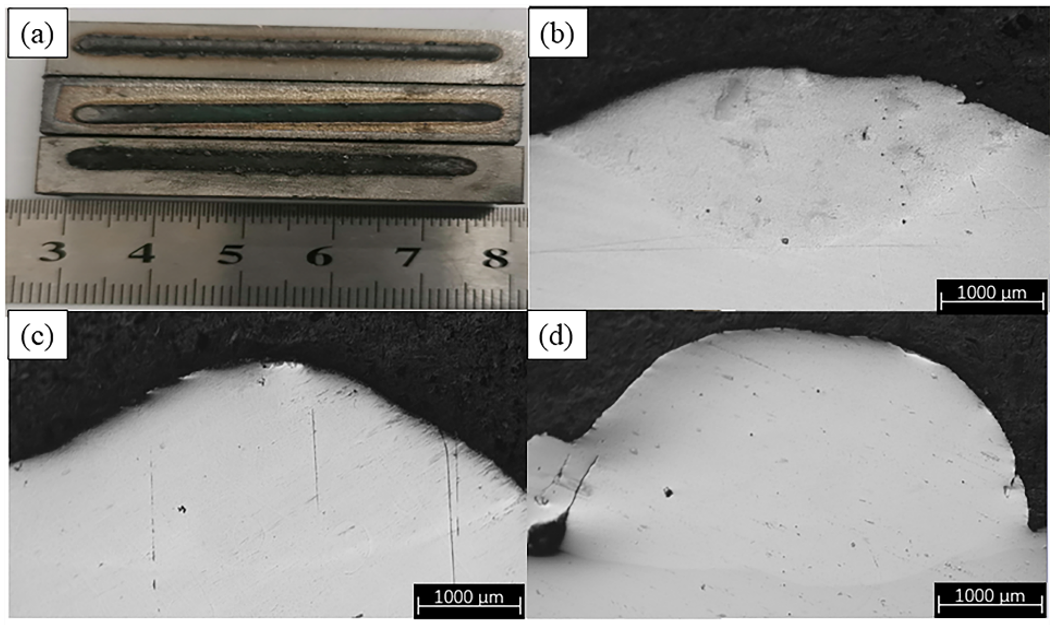
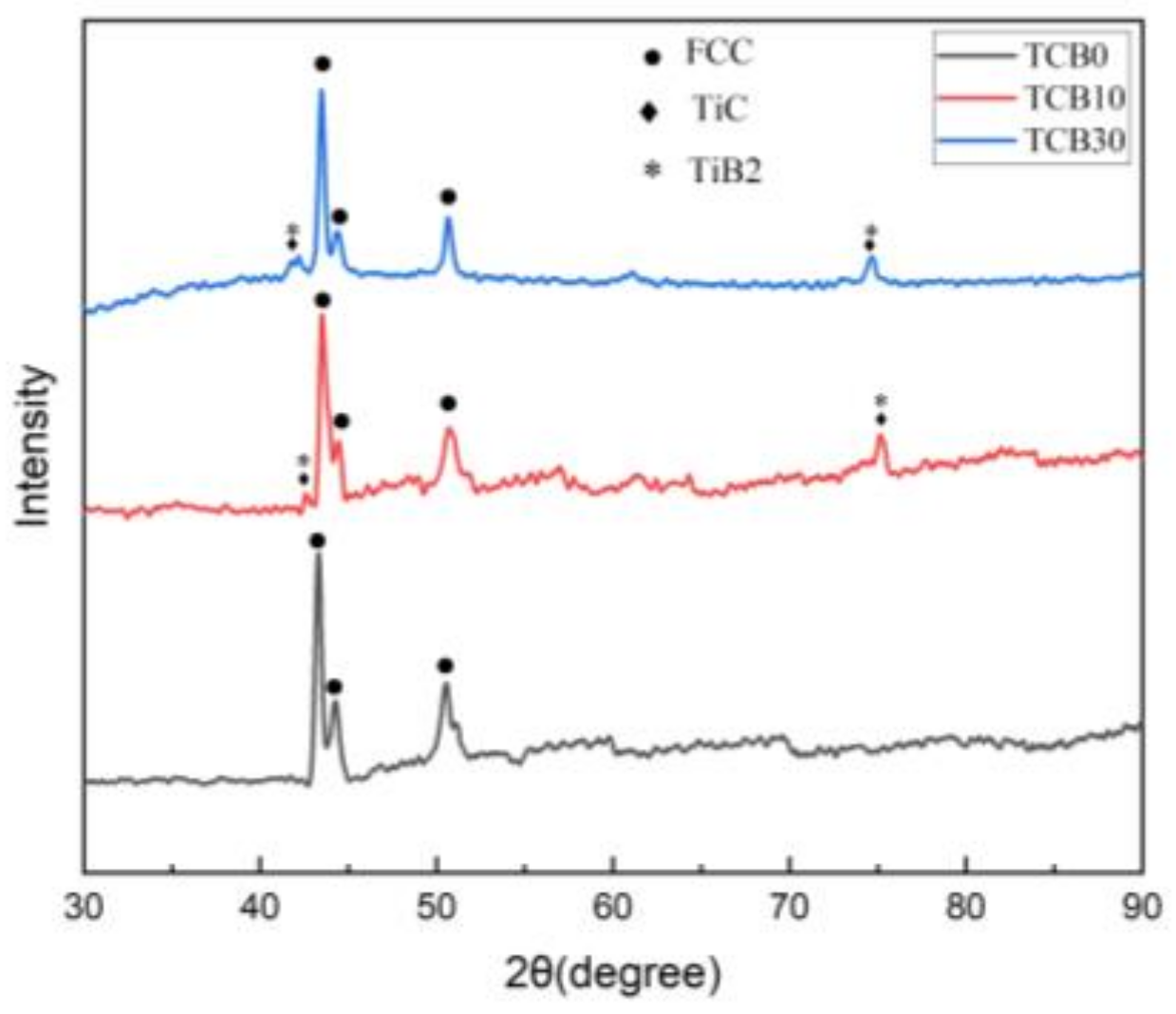
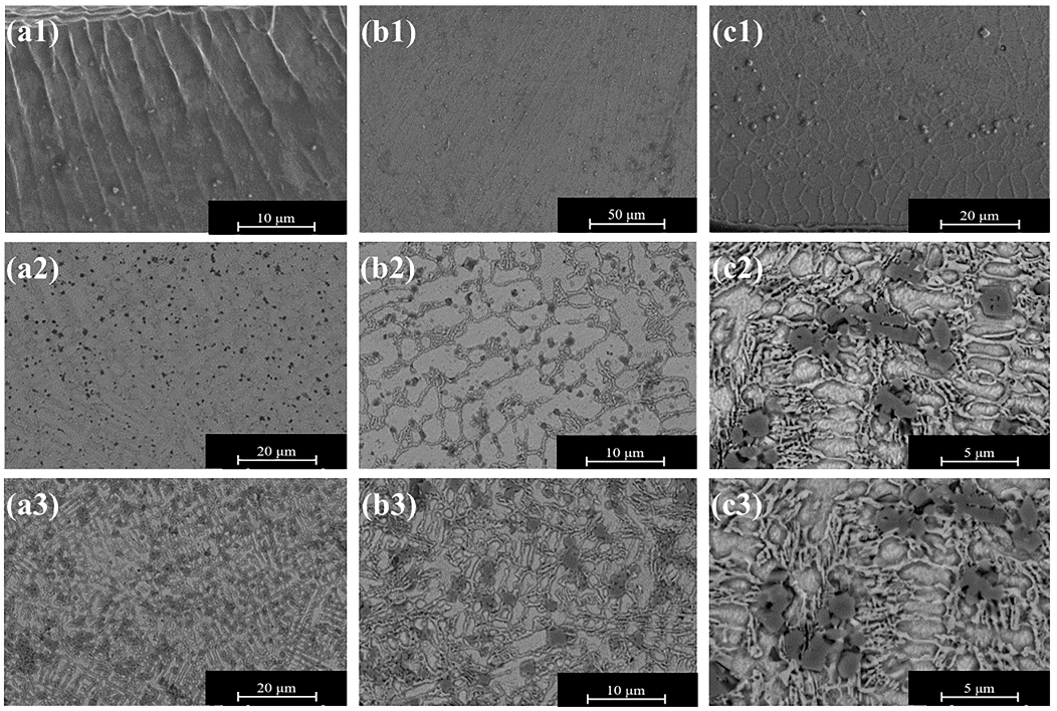


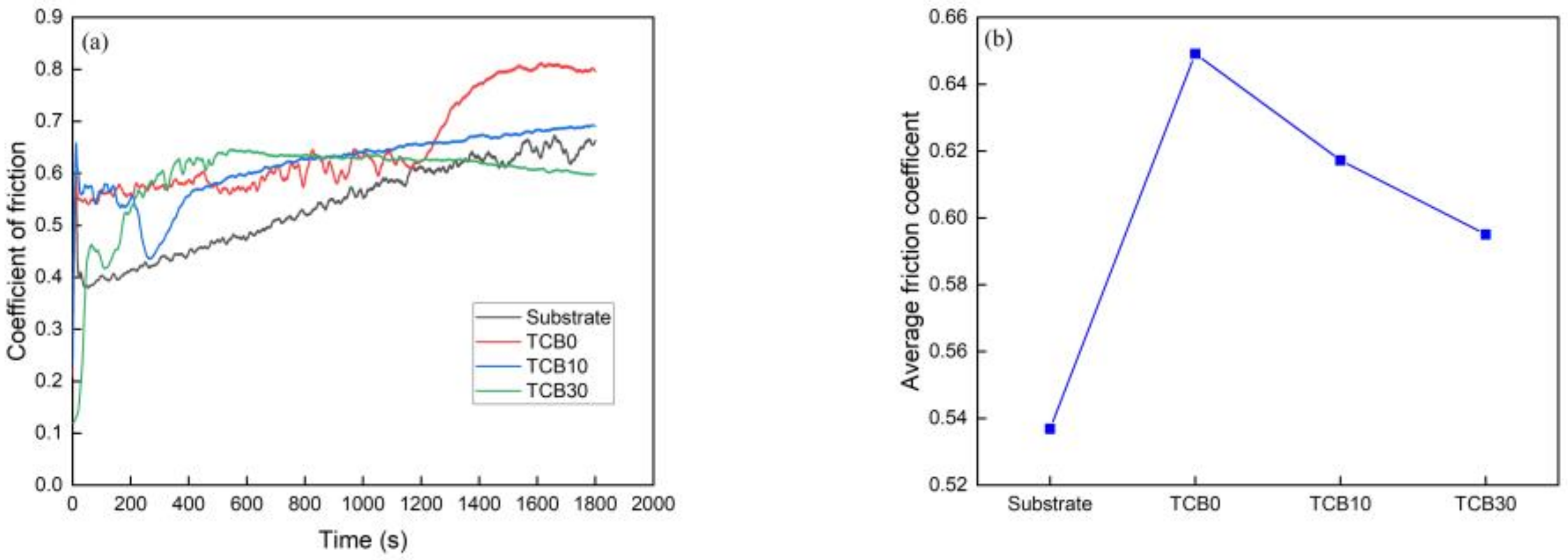
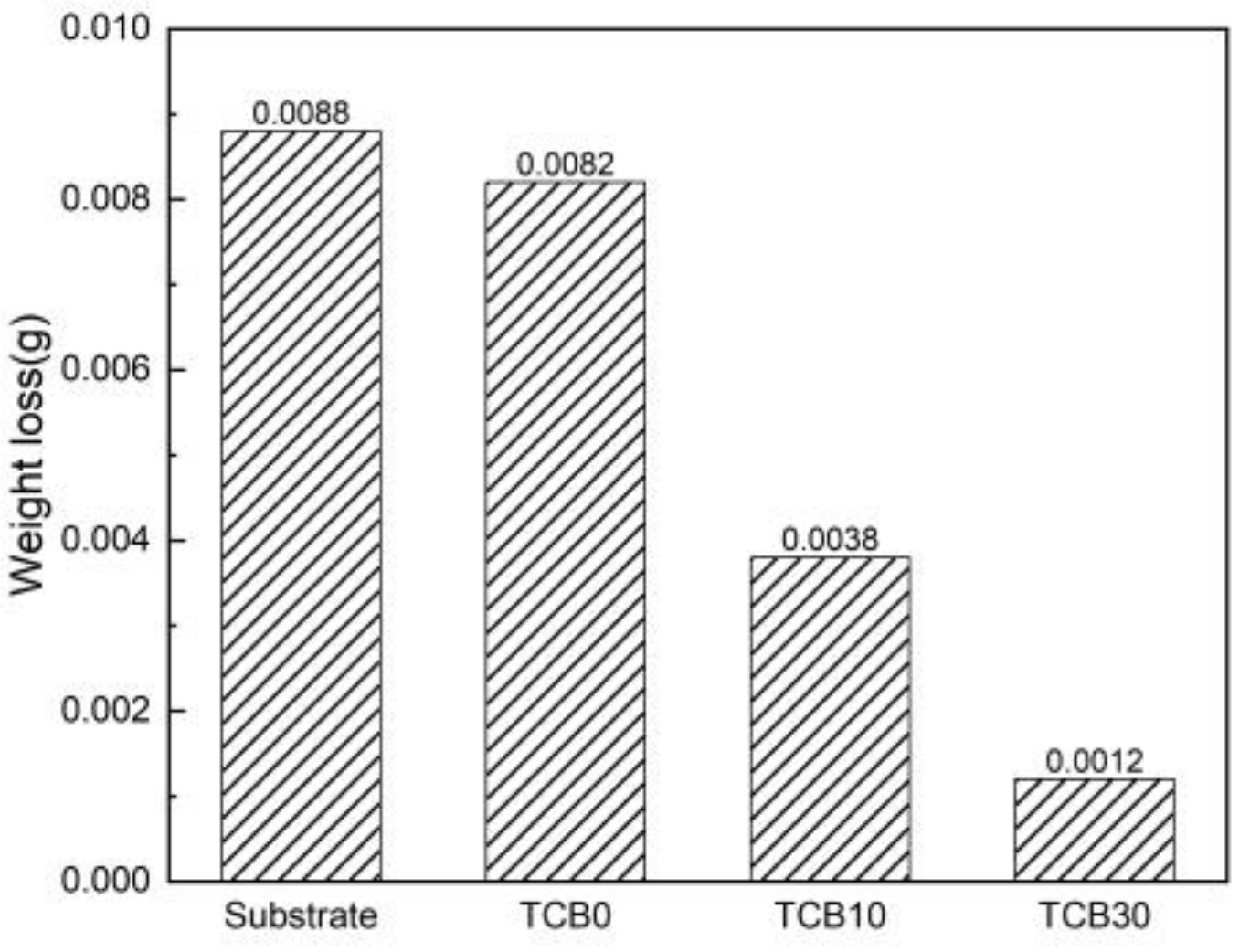


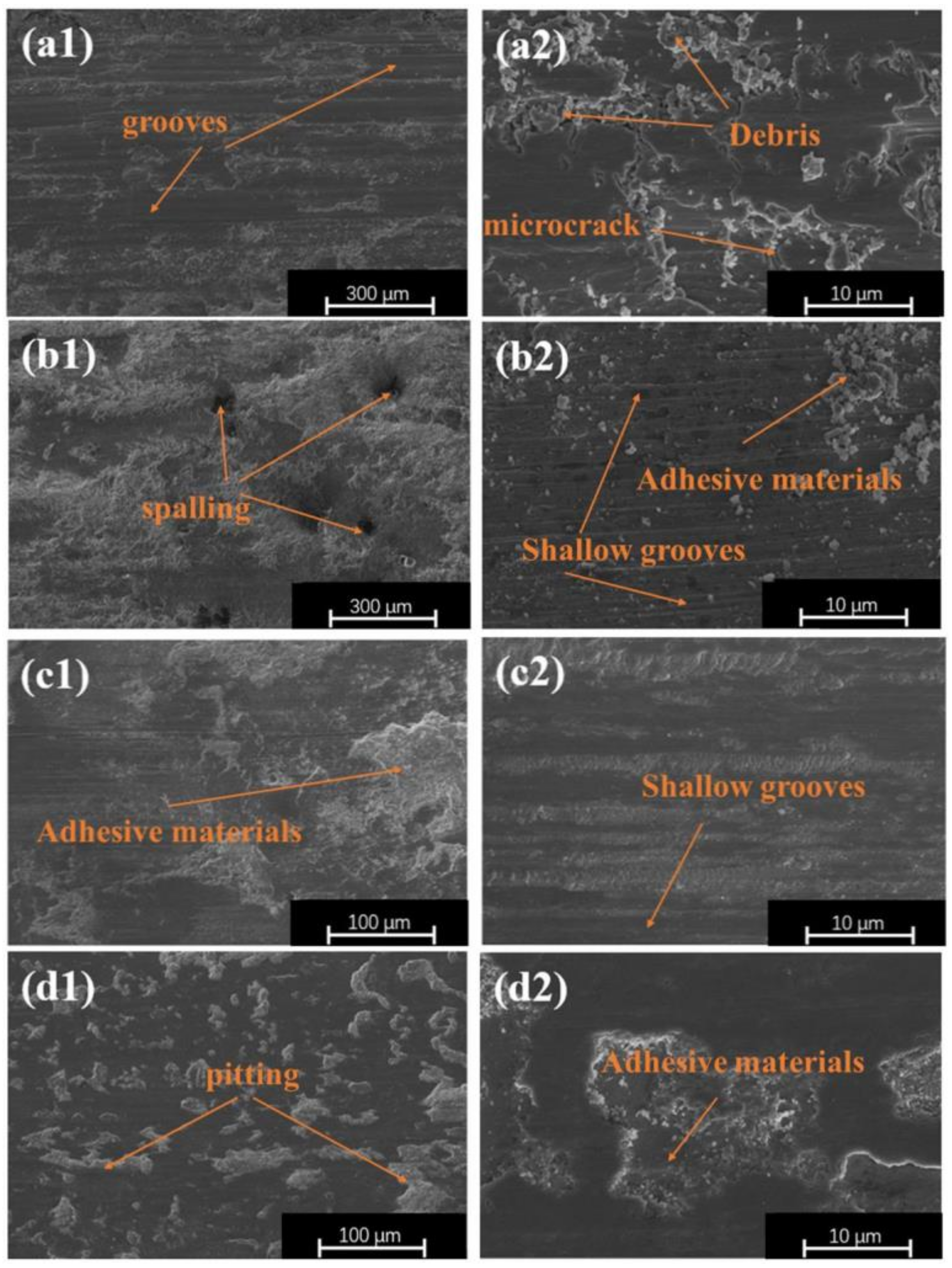
| Laser Power (W) | Scanning Speed (mm/s) | Spot Diameter (mm) | Protective Gas Flow (L/min) |
|---|---|---|---|
| 1000 | 10 | 4 | 10 |
| Coating Number | Powder Ratio |
|---|---|
| TCB0 | 100%CoCrNi |
| TCB10 | 90%CoCrNi + 5%TiC + 5%TiB2 |
| TCB30 | 70%CoCrNi + 15%TiC + 15%TiB2 |
| Coating Number | Depth of Cladding | Height of Cladding | Dilution Ratio |
|---|---|---|---|
| TCB0 | 250.86 μm | 730.18 μm | 25.57% |
| TCB10 | 255.70 μm | 544.70 μm | 31.95% |
| TCB30 | 499.55 μm | 344.81 μm | 59.16% |
| Co | Cr | Ni | Fe | B | C | Ti | |
|---|---|---|---|---|---|---|---|
| TCB0 | 30.34 | 32.02 | 30.29 | 7.34 | |||
| TCB10 | 16.88 | 20.97 | 19.59 | 25.91 | 7.92 | 5.56 | 3.19 |
| TCB30 | 5.47 | 17.93 | 8.13 | 27.84 | 16.08 | 13.53 | 11.01 |
| Samples | Ra | Rq | Rsk | Rku |
|---|---|---|---|---|
| Substrate | 31.009 | 36.422 | 0.7345 | 2.2999 |
| TCB0 | 29.878 | 35.295 | 0.7542 | 2.4443 |
| TCB10 | 17.700 | 20.569 | −0.2888 | 1.9766 |
| TCB30 | 3.244 | 4.438 | 0.3996 | 5.2368 |
Disclaimer/Publisher’s Note: The statements, opinions and data contained in all publications are solely those of the individual author(s) and contributor(s) and not of MDPI and/or the editor(s). MDPI and/or the editor(s) disclaim responsibility for any injury to people or property resulting from any ideas, methods, instructions or products referred to in the content. |
© 2023 by the authors. Licensee MDPI, Basel, Switzerland. This article is an open access article distributed under the terms and conditions of the Creative Commons Attribution (CC BY) license (https://creativecommons.org/licenses/by/4.0/).
Share and Cite
Liu, H.; Yu, Y.; Wang, X.; Gao, H.; Zhao, J.; Wang, H. Microstructure and Properties of CoCrNi/Nano-TiC/Micro-TiB2 Composite Coatings Prepared via Laser Cladding. Materials 2023, 16, 7016. https://doi.org/10.3390/ma16217016
Liu H, Yu Y, Wang X, Gao H, Zhao J, Wang H. Microstructure and Properties of CoCrNi/Nano-TiC/Micro-TiB2 Composite Coatings Prepared via Laser Cladding. Materials. 2023; 16(21):7016. https://doi.org/10.3390/ma16217016
Chicago/Turabian StyleLiu, He, Yuzhen Yu, Xi Wang, Hanpeng Gao, Jinku Zhao, and Hao Wang. 2023. "Microstructure and Properties of CoCrNi/Nano-TiC/Micro-TiB2 Composite Coatings Prepared via Laser Cladding" Materials 16, no. 21: 7016. https://doi.org/10.3390/ma16217016





